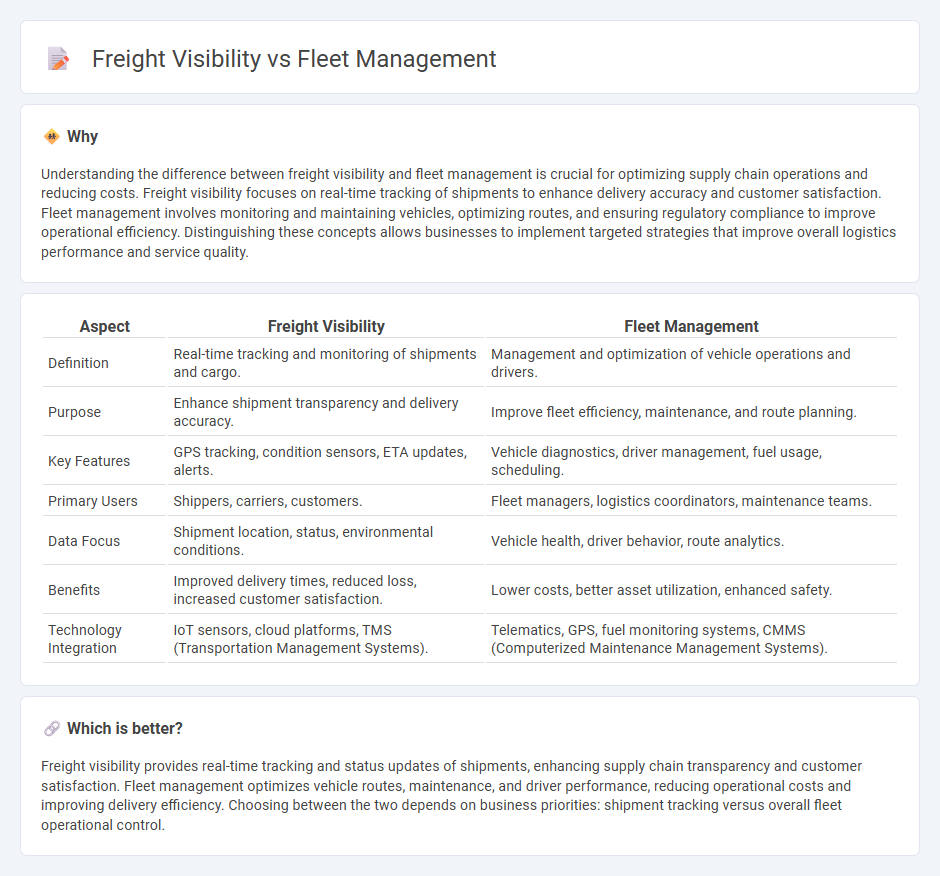
Freight visibility involves real-time tracking and monitoring of shipments to enhance supply chain transparency, whereas fleet management focuses on overseeing and optimizing vehicle operations for efficient transportation. Advanced logistics solutions integrate both elements to improve delivery accuracy, reduce costs, and increase customer satisfaction. Discover how combining freight visibility and fleet management can revolutionize your logistics strategy.
Why it is important
Understanding the difference between freight visibility and fleet management is crucial for optimizing supply chain operations and reducing costs. Freight visibility focuses on real-time tracking of shipments to enhance delivery accuracy and customer satisfaction. Fleet management involves monitoring and maintaining vehicles, optimizing routes, and ensuring regulatory compliance to improve operational efficiency. Distinguishing these concepts allows businesses to implement targeted strategies that improve overall logistics performance and service quality.
Comparison Table
| Aspect | Freight Visibility | Fleet Management |
|---|---|---|
| Definition | Real-time tracking and monitoring of shipments and cargo. | Management and optimization of vehicle operations and drivers. |
| Purpose | Enhance shipment transparency and delivery accuracy. | Improve fleet efficiency, maintenance, and route planning. |
| Key Features | GPS tracking, condition sensors, ETA updates, alerts. | Vehicle diagnostics, driver management, fuel usage, scheduling. |
| Primary Users | Shippers, carriers, customers. | Fleet managers, logistics coordinators, maintenance teams. |
| Data Focus | Shipment location, status, environmental conditions. | Vehicle health, driver behavior, route analytics. |
| Benefits | Improved delivery times, reduced loss, increased customer satisfaction. | Lower costs, better asset utilization, enhanced safety. |
| Technology Integration | IoT sensors, cloud platforms, TMS (Transportation Management Systems). | Telematics, GPS, fuel monitoring systems, CMMS (Computerized Maintenance Management Systems). |
Which is better?
Freight visibility provides real-time tracking and status updates of shipments, enhancing supply chain transparency and customer satisfaction. Fleet management optimizes vehicle routes, maintenance, and driver performance, reducing operational costs and improving delivery efficiency. Choosing between the two depends on business priorities: shipment tracking versus overall fleet operational control.
Connection
Freight visibility and fleet management are interconnected through real-time tracking technologies that enable accurate monitoring of shipments and vehicle locations. Enhanced freight visibility improves fleet management by optimizing route planning, reducing delays, and minimizing operational costs. Integrating these systems facilitates proactive decision-making and ensures efficient supply chain operations.
Key Terms
**Fleet Management:**
Fleet management involves coordinating and overseeing commercial vehicles to enhance operational efficiency, reduce costs, and ensure regulatory compliance through GPS tracking, maintenance scheduling, and driver performance monitoring. Advanced fleet management systems integrate telematics and real-time data analytics to optimize routes, fuel consumption, and asset utilization. Explore our detailed insights to understand how cutting-edge fleet management solutions can transform your transportation operations.
Telematics
Telematics technology enhances fleet management by enabling real-time tracking, vehicle diagnostics, and route optimization, which reduces operational costs and improves asset utilization. Freight visibility leverages telematics data to provide shippers and logistics managers with precise information on cargo location, condition, and estimated arrival times, enhancing supply chain transparency and customer satisfaction. Explore detailed insights on how telematics transforms fleet management and freight visibility for smarter logistics solutions.
Route Optimization
Fleet management integrates GPS tracking and telematics data to enable dynamic route optimization, reducing fuel consumption and improving delivery times. Freight visibility leverages real-time shipment tracking and predictive analytics to enhance route planning accuracy and proactively address delays. Explore how combining these technologies advances precise and efficient route optimization for logistics.
Source and External Links
What is Fleet Management? - IBM - Fleet management involves overseeing a business's vehicle fleet including maintenance, driver management, fuel management, compliance, and route optimization using software to improve efficiency and reduce costs.
What Is Fleet Management? (A Fleet Managers Guide) - Geotab - Fleet management is the process of vehicle acquisition, maintenance, tracking, driver behavior management, fuel efficiency, compliance, and continual improvement to optimize fleet operations and lower costs.
Fleet management - Wikipedia - Fleet management is the function of managing commercial and private vehicles and related assets for a business, including telematics, compliance, maintenance, driver and fuel management to reduce risks and improve productivity.
 dowidth.com
dowidth.com